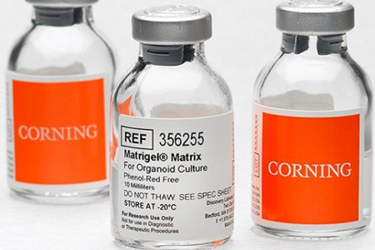Corning Matrigel Matrix— The Original, Trusted Extracellular Matrix

Nearly 30 years ago, researchers were looking for a way to grow mouse sarcoma cells. The solution? The development of Corning Matrigel matrix. Matrigel is a solubilized basement membrane preparation extracted from the Engelbreth-Holm-Swarm (EHS) mouse sarcoma, a tumor rich in such ECM proteins as laminin (a major component), collagen IV, heparan sulfate proteoglycans, entactin/nidogen, and a number of growth factors.
Today, this natural ECM-based hydrogel is among the most widely used models for 2D and 3D cell culture in vitro, enabling you to:
- Improve the attachment and differentiation of both normal and transformed anchorage-dependent epithelioid cells, as well as other cell types.
- Better mimic in vivo environments for 2D and 3D cell culture applications.
Applications
Corning Matrigel matrix is effective for the attachment and differentiation of both normal and transformed anchorage-dependent epithelioid and other cell types. These include neurons, Sertoli cells, chick lens, vascular endothelial cells, and hepatocytes.
Applications include:
- Influencing gene expression in adult rat hepatocytes
- 3D culture in mouse and human mammary epithelial cells
- In vivo peripheral nerve regeneration
- Metabolism and toxicology studies
- The development of several types of tumor cell invasion assays
- The in vitro and in vivo study of angiogenesis
- In vivo propagation of human tumors in immunosuppressed mice
- The maintenance of human embryonic stem cells and induced pluripotent stem (hiPS) cells
- Neuronal differentiation of hiPS cells
Matrigel Matrix Quality Control Specifications
- Mouse colonies routinely screened for pathogens via mouse antibody production (MAP) testing
- LDEV-free EHS tumor
- Extensive PCR testing performed on a number of pathogens, including LDEV, ensuring strict control of raw materials used during manufacturing
- Tested and found negative for the presence of bacteria, fungi, and mycoplasma
- Protein concentrations determined by Lowry method
- Endotoxin units measured by Limulus Amoebocyte Lysate assay
- Gel stability tested for a period of 14 days at 37°C
- Biological activity determined for each lot using a neurite outgrowth assay; chick dorsal root ganglia, plated on a 1.0 mm layer of Corning Matrigel matrix, required to generate positive neurite outgrowth response after 48 hours without addition of nerve growth factor
